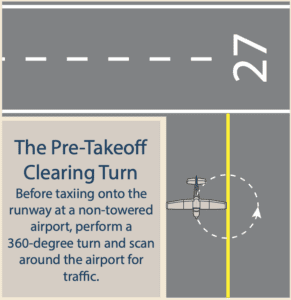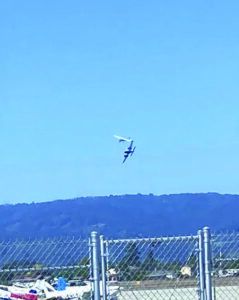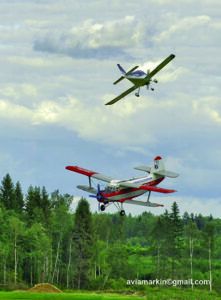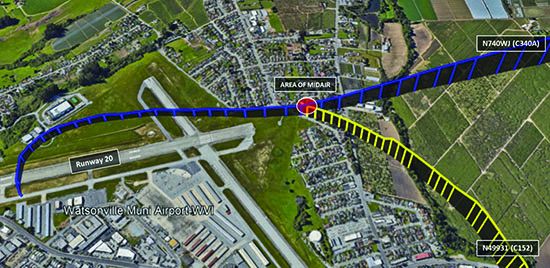Every flight starts with procedures and checklists for ensuring we follow all of its steps correctly. We have procedures for preparing the aircraft for flight, we have procedures for how to depart the airport and we have procedures for returning. These procedures are designed to help the pilots ensure that the aircraft is operated safely, that steps aren’t forgotten and so that we are led toward a path of safety and away from risk.
To a new pilot, these procedures can feel cumbersome and perhaps a bit overwhelming. There is so much to know for someone who is just starting to become a pilot. There is also comfort knowing that if you do something the same way time after time, that the result will be the same. That’s all well and good, but checklists aren’t the only things a pilot should be devoting attention to.
ALREADY FLYING
For example, I was with a student the other day. We were fueling the aircraft when I noticed an exhaust stack was loose. As I finished fueling the aircraft, the student who had just preflighted it was ready to jump in and go for a night flight.
He was so comfortable in the preflight procedure that he never thought to look beyond the items specifically called out on the checklist and investigate why one exhaust stack was rigid and the other was loose. Of course, every aircraft rented should be kept in top-notch condition, but something unreported may have happened on the previous flight, leading to the loose stack. Regardless, it’s up to the pilot to verify that the aircraft is in fact airworthy.
Another common issue I observe is that as soon as the student announces that they are going to take the runway, in their mind they are already flying. They no longer notice that the window is open, or that the checklist has not been completed. In their mind they are already flying, and that is all they are concentrating on.
These behaviors are rooted in inexperience, and only experience—perhaps with an occasional, healthy dose of abject terror—will overcome them. The recent spate of fatal mid-air collisions, one at the North Las Vegas airport and another at my home plate, the Watsonville (Calif.) Municipal Airport, have highlighted the “see and avoid” concept for a number of pilots, at least when it comes to collision avoidance. But avoiding a mid-air collision is not the only way to apply the concept. By way of explanation, let me first explore the Watsonville mid-air. The graphic on the opposite page may be helpful.

As Tom Turner mentioned in his “Mid-Air Strategies” article (October 2022), “When I first learned to fly it was normal to make a tight, 360-degree turn on the taxiway to scan for traffic all around before venturing onto the runway. This helps you catch the pilot in the non-standard pattern, too. I did this pivot religiously when I flew a no-radio Cessna 120.”
I was trained the same way. Although there’s often nothing to see, this simple maneuver has saved my bacon more than once.
It’s a really simple maneuver: Before taxiing onto the runway for takeoff at a non-towered airport, slowly pivot the airplane around on the taxiway and scan the airspace around you for other airplanes, and not just on short final. You can do this in the runup pad or on the taxiway itself—maybe give yourself some space by displacing a bit in the direction opposite your planned turn.
It’s a simple, effective way to ensure that you have good awareness of the situation around you in the pattern and behind you waiting to go next before taking off yourself.— J.B.
THE WATSONVILLE MIDAIR
The mid-air collision occurred August 18, 2022, at about 1455 Pacific time. The two airplanes involved, a Cessna 152 and a Cessna 340, were destroyed. The solo pilot aboard the 152 and both the pilot and passenger on the 340 were fatally injured.
About the time the 152 became established on the downwind leg for Runway 20, the 340 announced it was three miles out on a straight-in approach to the same runway.
We likely will never know what the pilot in the 152 knew about the 340, but my guess is not much. For example, did he know that the 340 is a much faster aircraft, with an approach speed of 100-110 knots compared to the 60-knot approach speed of his 152? It’s likely the 152 pilot also was not aware that the 340 was descending from 7000 feet and needed to maintain 3000 feet to clear the mountains five miles from the runway, meaning the aircraft likely would have been moving even faster than a 110-knot approach speed, perhaps closer to 170 knots as it descended on final. Regardless, I would argue that the better question is if it was you in the 152, would you have recognized how much faster that 340 was, and how much of a hazard it posed to you, not just because it was much faster but because it was aiming for the same spot at the same time?
After the 152 turned onto a left base leg, the 340 called a one-mile final. This point in time was one of the last opportunities for either pilot to avoid what was to come. For example, instead of turning onto the base leg, the 152 pilot could have extended their downwind leg, allowing the 340 to land first, or exited the pattern entirely out of an abundance of caution.
Meanwhile, the 340 pilot could have remained above the traffic pattern altitude, used the new vantage point to determine the location of other traffic and entered the pattern safely, with a much better idea of where any conflicting traffic was. For example, the 340 pilot could have remained 500 feet above the traffic pattern altitude and flown to enter the downwind leg on the 45, per the FAA’s recommendations. Neither of them made these choices.
The 152 pilot ultimately determined that the 340 was behind them, and according to NTSB’s preliminary report, stated he was going to go around, “because you are coming up on me pretty quick.”
Of course, a 152 does not have the ability to match speed with a 340. However, when the 152 pilot initiated a go-around, they gave up what little speed they did have in exchange for a climb.
And then the pilots were out of options: The 340 and the 152 collided, resulting in catastrophic damage to both aircraft, and the loss of three lives.
FAILURE TO SEE AND AVOID

It shows the 340 in a steep right bank as its left tip-mounted main fuel tank appears to collide with the 152’s left wing. The 340 does not appear to have its landing gear extended, giving rise to speculation the 340 pilot was planning a fast, low pass over the runway or had retracted the landing gear as part of a go-around procedure.
Source: NTSB
Among other things, I’m a flight instructor flying out of Watsonville. Naturally, I’ve been asked many times to evaluate how this tragedy came to be, what differences from “normal” were present and, of course, how to prevent it from happening again. Ultimately, the NTSB will publish its findings and provide a final set of facts and evaluation of the accident. Until then, based on the facts that are known, and from my perspective, both pilots failed to understand the hazards posed by the other airplane and then take appropriate action. The record is fairly clear.
Both pilots had been communicating with each other over the radio, on the common traffic advisory frequency. They both knew the other was planning to land on Runway 20. They both knew the other airplane was out there and posed a conflict. They were engaged in the kind of communication we should expect at a non-towered facility. They both simply failed to act to prevent what happened.
In other words, this was not a case involving poor visibility, a technical failure aboard one or both airplanes, lack of communication or an ATC error, since the airport is non-towered. At its foundation, this is simply a case where each pilot failed at seeing and avoiding the other aircraft.
ACCIDENT CHAIN
Either way, this type of situation is not uncommon in general aviation, particularly at non-towered airports. We often talk about the accident chain. Did the 152 pilot fail to understand how to manage their flight path to avoid a much faster aircraft in the pattern? Did the 340 pilot lose track of his speed while focusing on looking for the traffic in the pattern?
Perhaps the answers to these questions will never be known. Perhaps the most instructive lesson that we can learn goes something like, “Recognize the possible outcomes and avoid them in how you fly the aircraft you are commanding.”
What can we as a community do to learn from this event, and help prevent its recurrence?

In our May 2020 issue, I wrote an article, “Defensive Flying,” which mainly focused on my recent experiences flying near some non-towered airports in my neighborhood. In one instance, I detailed coordinating with a Twin Cessna departing an airport I was flying past, above its pattern. The Twin Cessna driver and I communicated our intentions and actions, with me choosing to turn 30 degrees off-course to ensure separation between us as the other airplane turned on course and climbed out. Needless to say, we spotted each other easily, because we knew where to look and, obviously, avoided a conflict.
Although we both knew about the other, I was the one who volunteered to change course; the Twin Cessna driver may have figured he would easily climb above my altitude before he got too close, but what if he hadn’t? What if we both had stuck with our original intent and hadn’t even been on the correct frequency? — J.B
UNDERSTANDING THE WHY
Let’s go back to the discussion with which I started this article, involving students and relatively inexperienced pilots. One of the points I was trying to make is these pilots often have a rote understanding of the order and nature of flight operations, but they yet don’t understand why some things are done a certain way. They don’t understand the risks of not following the checklist down to the details, nor how going beyond the checklist—please show me where it says “wiggle the exhaust pipe to verify its security”—but often that’s exactly what we should be doing.
Sometimes they are in such a rush to get airborne that they can’t wait for the landing aircraft to clear the runway before moving into position and holding, or lining up and waiting, if you prefer. At a towered airport where a controller is watching and you’ve been cleared to do that, it’s usually not a problem. At a non-towered airport, why would you put your back to oncoming traffic? It’s also a rule violation.
The FAA’s FAR 91.113(b), right of way rules except when operating on water, states in part: “When weather conditions permit, regardless of whether an operation is conducted under instrument flight rules or visual flight rules, vigilance shall be maintained by each person operating an aircraft so as to see and avoid other aircraft.” How can you be vigilant with your back to the traffic?
Also, how can you be vigilant when part of the airplane structure is blocking your view? Another opportunity for vigilance is when a pilot in the traffic pattern turns from one leg to another. The most dangerous in my experience is the upwind-to-crosswind turn: There is the possibility an aircraft taking off behind you will try to turn inside you. If you are in a high-wing airplane like a Cessna 152 or 172, the wing will block your view of the airspace you are turning toward. The pilot cutting the corner likely is in a faster airplane, and it is possible you will hit it as you turn your crosswind.
SEEING AND AVOIDING
The Watsonville mid-air can be thought of as something of a Rorschach inkblot test for pilots: What do they see in it? Is it a failure of the see-and-avoid concept? Sure. Is it a wake-up call to be more vigilant in our flying, especially in the traffic pattern? Absolutely. Is it a reminder that all of the warning signs we can identify in such a circumstance are meaningless if we don’t react to them? Yes.
But it’s also a warning that sometimes we need to think outside the box created by our normal operations, those in which we see only the norms of rote checklist performance and fail to put out even minimal extra effort to avoid a calamity. Think of it also as a failure of imagination. If all the holes in the Swiss cheese become aligned, what’s the worst that can happen? How will you prevent it—how will you cause the holes in the cheese to get out of alignment?
The Watsonville mid-air might best be thought of as a failure of imagination. Neither pilot envisioned a future in which the other failed to see and avoid them, and consequently couldn’t conceptualize that they themselves had to take responsibility for preventing the inevitable result. They failed at seeing beyond the checklist and avoiding the outcome.
J.R. Warmkessel holds FAA flight, instrument and multi-engine instructor certificates, and is an A&P/IA. He’s also an aviation podcaster and IT professional living in the San Francisco area.




